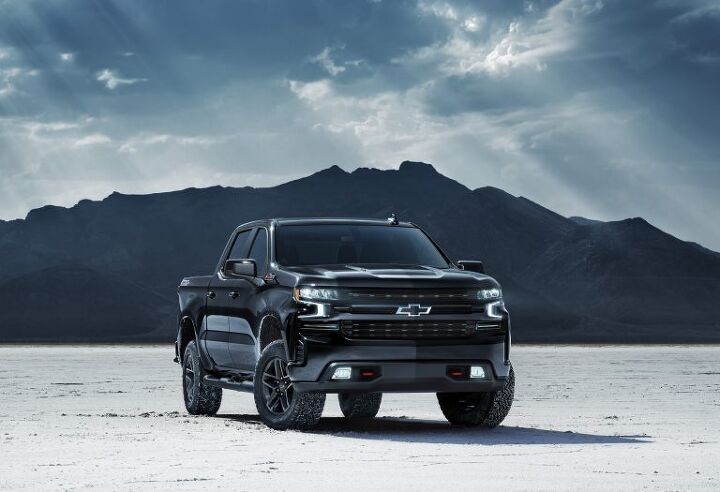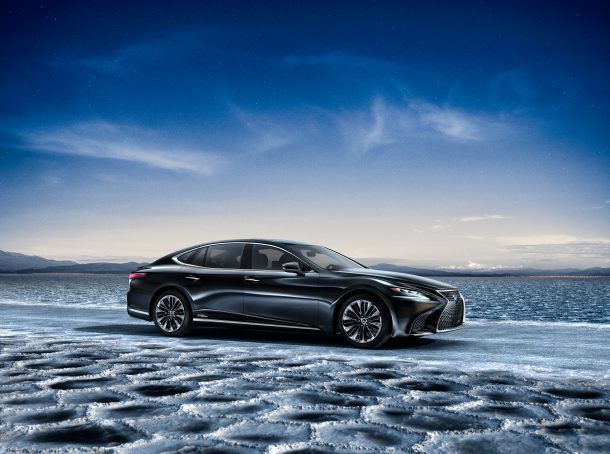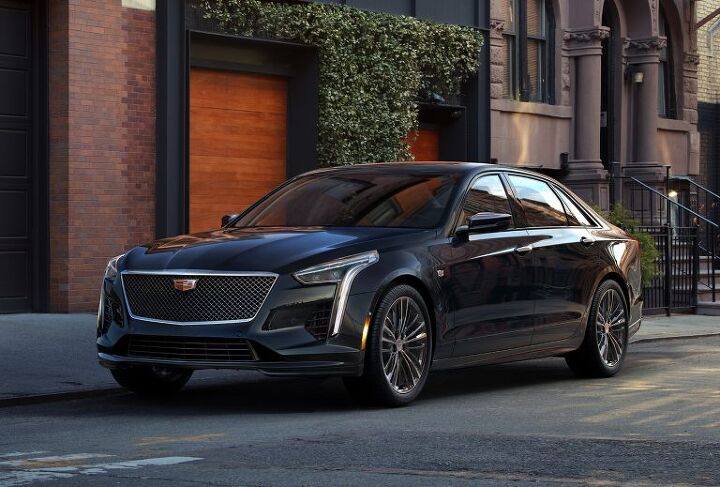#CadillacCt6
GM Recalls More Than 900,000 Vehicles Worldwide Over Brake and Battery Issues
General Motors is recalling more than 900,000 vehicles across the globe to addresses issues from separate campaigns — one of which poses an always-exciting fire risk. On Thursday, the automaker announced a callback of more than 400,00 Chevrolet Silverado and GMC Sierra 1500 trucks from the 2019-2020 model years. The manufacturer is concerned that pickups’ battery positive cable rings may have been installed with excessive glue, creating a stalling risk, or in some instances a potential fire hazard.
Another 550,000 Chevrolet Silverado 1500, Cadillac CT6, and GMC Sierra 1500 models from 2019 will also need to be recalled. A potential software issue related to the vehicles’ service brake system notifications could cause it to go haywire, negatively impacting their electronic stability control (ESC) and anti-lock braking (ABS) functions.
Tombstone Date for Two Large GM Sedans Revealed
Just a couple of days ago, your author’s eyes were drawn to a brand spankin’ new, dark red Chevrolet Impala sitting in a parking lot — one made all the more distinctive by black five-spoke steel wheels. Tis the winter season, after all.
The Impala’s design always garnered a nod of approval from this writer, a person whose former ME once referred to as a raging GM apologist, though the model’s rear-seat headroom is definitely lacking. It’s also a Chevrolet and not a Mercedes-Benz. All of that aside, fans of traditional full-size sedans, especially those of the domestic variety, can mark two dates on their calendar. The Impala is leaving forever, and it seems the model’s Cadillac CT6 factory mate will not get the lease on life some expected.
Buy/Drive/Burn: $60,000 Luxury Sedans in 2020
Say you’re an auto shopper of wealth and taste who has around $60,000 to spend. Now, let’s assume the usual options from Japan and Germany are not for you. Would you turn to America or Sweden to fill your luxury needs?
Report: Engine Options Shrink to Two for 2020 Cadillac CT6
Cadillac’s CT6, which remains without a home after January 2020, will shed an engine offering for the upcoming model year.
The report comes by way of AutoVerdict, which got its hands on a 2020 CT6 order guide. Initially offered with a 2.0-liter four-cylinder for the base, rear-drive model, the CT6 range spanned a plug-in hybrid model (utilizing that same 2.0-liter), a 3.6-liter V6, twin-turbo 3.0-liter V6, and, as of 2019, a 4.2-liter Blackwing V8.
For 2020, only the naturally aspirated V6 and the Blackwing remain.
A Brief Reprieve for Detroit-Hamtramck Assembly
Detroit-Hamtramck, one of the five North American plants General Motors plans to shutter before the end of the year, will instead linger online a little longer.
While the plant’s future is still very much in doubt, and the lights will certainly go off for at least some period of time, the automaker plans to keep cranking out cars past New Year’s Eve. The reprieve stems from GM’s interest in continuing production of the Cadillac CT6 and Chevrolet Impala. Not the Buick LaCrosse or Chevrolet Volt, though. Definitely not the Buick LaCrosse and Chevrolet Volt.
With CT6-V Sold Out, Cadillac Poised to Drop a Second V8 Shoe
We’ve hinted at this before, but now there’s order guides and pricing to share. While Cadillac’s CT6 flagship sedan will soon be without a home, General Motors hasn’t said anything about dropping the model. Once Detroit-Hamtramck Assembly shuts off the lights, GM would like to source its full-size sedan from some other place, be it China or another U.S. factory.
In the interim, there’s a new engine poised to appear beneath the sedan’s hood.
Cadillac's CT6 Isn't As Dead As You Thought
General Motors’ future passenger car lineup might not be as threadbare as initially thought. After sparking continent-wide hair pulling with its decision to shutter three assembly plants and cull six car models in the process, it seems the most prestigious vehicle of the bunch might live on after its plant goes dark.
The Cadillac CT6, which first hit U.S. sales charts in March of 2016, isn’t officially dead. It seems GM didn’t get its story straight back in late November, as Caddy’s flagship sedan might live on with another home base.
Buy/Drive/Burn: Large Luxury Sedans of Compromise in 2018
Three large and luxurious sedans compete for around $70,000 of your hard-earned and imaginary Internet dollars. Surely this is a segment where compromise will not be a concern, right?
Nope.
GM to Shed Five North American Plants, Numerous Products, Amid Restructuring Drive
Heavy-duty streamlining has reached the production level at General Motors. After last night’s bombshell (though not unexpected) report claiming Canada’s oldest auto plant would cease operations late next year, more news is trickling out about the automaker’s production future.
Add Ohio and Michigan to the list of locales expected to lose an assembly plant.
Cadillac Loses Its Only Hybrid Model
As one hat joins the wardrobe, another leaves the closet for a trip to the goodwill store. Cadillac’s flagship CT6 appeared at dealers in early 2016 with a range of powerplants in tow, most notably a plug-in hybrid promising 31 miles of gas-free driving. Big, traditional, American luxury sedans needn’t be dinosaurs, Cadillac said of the lightweighted plug-in.
Well, an asteroid just fell on a new, green Detroit.
Cadillac Names New 'V' Model, Gives Two Others the Last Rites
Something needs to carry Cadillac’s performance banner into the future, and, with three of its four sedans slated for execution within the next year, GM’s luxury brand has decided the sole remaining car should be it. Tough decision, that one.
At least it’s not the XT5.
Late Wednesday, Cadillac announced the flagship CT6 V-Sport, bowing for the 2019 model year, will henceforth be known as the CT6-V. In the Cadillac stable, V-Sport models see a significant uptick in power, with the real scorching stuff carrying a -V signifier. Luckily, the CT6 V-Sport stands to gain an engine of considerable output when it arrives in the spring.
2019 Cadillacs: CT6 Drops Entry-level Engine, and Is the ATS Going Coupe-only?
After a relative lull in product introductions, Cadillac has a pipeline of new vehicles ready to boost the brand’s fortunes. Or so the General Motors division hopes.
In early 2016 Cadillac launched the XT5 crossover and CT6 sedan, following it up with a refreshed XTS in late 2017. Next year brings bigger news in the form of the XT4 compact crossover, with at least one other crossover waiting to plug another hole in the brand’s utility lineup.
But what about Cadillac’s older sedan lineup — the one that’s not bringing in anywhere near the passenger car volume the brand once enjoyed? There’s a long-range plan to deal with that, but first the company has some careful surgery planned.
Cadillac Changes Its Super Cruise Strategy, Commences Media Campaign Prior to Launch
Setbacks notwithstanding, we’ve been eagerly anticipating Cadillac’s entry into the world of semi-autonomous driving with its Super Cruise system, developed to help reinforce the automaker’s position as top-tier luxury brand. After all, vehicular opulence is now deeply embedded with technological achievement and few things shout “I’ve arrived” like a car that can chauffeur you around.
However, Cadillac is changing its implementation strategy, making Super Cruise standard on the highest trimmed CT6 — instead of leaving it as a pricy optional extra. It’s also launching an advertising campaign to whet the public’s appetite, with the first of its “Let Go” TV spots appearing on MTV’s Video Music Awards over the weekend.
QOTD: Lincoln Continental Vs. Cadillac CT6 - Pick Your Poison
Today’s Question of the Day isn’t our typical lighthearted, open-ended Choose Your Own Adventure inquiry. It’s serious business, pitting two serious flagship sedans against one another.
At the end of this post, you’ll have to choose: Lincoln Continental, or Cadillac CT6?
Cadillac Boss Lays Out Brand's Sedan Strategy; Is a Stripper CT6 on the Way?
Lately, it seems everyone wants to talk about Cadillac sedans. Too bad few people want to buy one. The future of the storied brand’s traditional passenger car offerings was recently called into question by a report claiming two Cadillac sedans, including the CT6, are slated for execution.
Hashtag fake news, brand president Johan de Nysschen responded. In a reply only slightly less vague than the initial report itself, the brand president said no sedan models were on the chopping block. Nope, the Cadillac lineup will strut into the 2020s with three sedans, he said, making no mention of the fact Cadillac has four sedans.
Okay, so we knew the aging (but facelifted for 2018) XTS had no long-term future. But what about the survivors? In a recent interview, de Nysschen spelled out the plan.






























Recent Comments